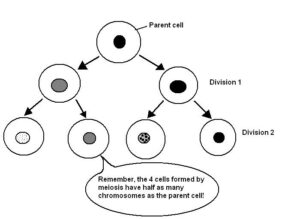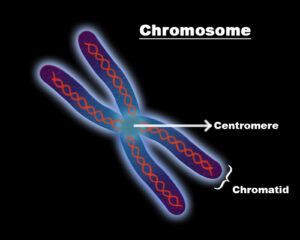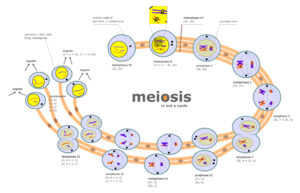Genetic diversity is a concept in which the variety of characteristic features of one specific organism present on the basis of genetics like different breeds of dogs, cats or variety of rose, hibiscus flowers.
Genetic diversity in meiosis is based on 2 factors, One is the crossing over and the random arrangement or alignment of homologous pairs of chromosomes. Recombination happens and new variants of the same species emerge by the process of cell division called the meiosis. Meiosis is the only process in which a diploid cell that is “2n” becomes hapoid which is “n”.
This article completely focuses on explaining the topic Genetic diversity In meiosis in a very explicit way.
What is genetic diversity in meiosis?

Image credits- Wikimedia
In comparison with mitosis, meiosis shows or creates more genetic variation.
There are 2 factors- crossing over and random arrangement or the independent assortment.
- Independent Assortment: The formation of random arrangement in chromosomes is called an independent assortment which leads to genetic variation in meiosis. This is also called random alignment or arrangement.
- Crossing over: Exchange of genes among the homologous chromosomes which leads to the recombinant chromosomes which has the possibility in which the gene can have the parent cell gene.
What is the genetic diversity in meiosis in comparison with mitosis?
In comparison with mitosis, meiosis shows or creates more genetic variation.
- In meiosis, four cells are produced from the parent cell and they are not genetically identical to their parent cell.
- In mitosis, 2 cells are produced which are definitely identical to the parent cell.
What are Sources of genetic diversity in meiosis?
As discussed earlier, there are two sources of genetic diversity in meiosis.
The two sources of meiotic genetic diversity are the independent assortment or also called as random arrangement and the second one the crossing over process.
Read More on Difference between animal and plant cell chromosomes: Comparative analysis on structure, function and facts
What are the causes of genetic diversity in meiosis?
Meiosis is a significant process in which a diploid cell (2n) becomes haploid cell (n).
Recombination is a systemic process in which new variants or to be more clear now versions of the same species cells emerge. Recombination is the major cause of genetic diversity in meiosis.
Read More on Why chromosomes are in pairs: comparative analysis on structure, function and facts.
What is genetic variation in general?
Genes are the functional unit of heredity.
Genetic variation is the variety of genes or the genetic differences that take place between the same species.
Example: The parents both father and mother, have brown hair but the child has dark black hair. This is because the child has got the genes responsible for hair from one of their grandparents.
So the child has genetic variation in comparison to parents.

Image credits- Flickr
Read More on Are Bacteria Prokaryotic Or Eukaryotic: Why, How And Detailed Insights And Facts
What is Meiosis?
Meiosis is a process of cell division. It is a process in which one single parent cell produces four cells with half the number of chromosomes from which the cells that they were originated from, that is the parent cell.
So this is a significant process in which the diploid cell becomes haploid.
Read More on Sequence Of Nitrogenous Bases In RNA: What, Why, Purpose, Detailed Facts
There are few stages involved in this process of cell division.
- Prophase-I
- Metaphase-I
- Anaphase-I
- Telophase-I and Cytokinesis
- Prophase-II
- Metaphase-II
- Anaphase-II
- Telophase-II and Cytokinesis

Image Credits- Wikimedia
Prophase-I:
The thin strand of chromatin condenses and forms compact short chromosomes which is called the chromosome condensation. Then the nuclear envelope breaking open finally leads to the process of crossing over.
Metaphase-I
These homologous pairs of chromosomes are transported to the center of the cell known as the equator region of the cell.
Anaphase-I:
Now, each homologous chromosome moves towards the opposite poles of the cells.
Read More on Nucleotide Excision Repair and Single Nucleotide Polymorphism | An Important discussion
Telophase-I and Cytokinesis:
The chromosomes grouped in the opposite poles, the division of cytoplasm takes place.
Prophase-II:
Spindle formation takes place at this step.
Metaphase-II:
The chromosomes gather into the equator that is the middle or the center of the cell.
Anaphase-II:
The chromatids reach to the opposite poles and the centromeres division takes place.
Read More on Is Cyanobacteria Unicellular Or Multicellular: Why, How And Detailed I
Telophase-II and Cytokinesis:
Disappearance of spindle fibers and formation of nuclear membrane around the chromosome sets takes place.
Also Read:
- How to increase strength of a magnetic field
- Magnetic flux in a magnetic circuit
- Magnetic flux and current
- Bar magnet uses
- How to increase the strength of an electromagnet
- What produces the strength of a magnetic field 2
- Magnetic flux vs magnetic field
- Magnetic field vs magnetic field strength
- Is magnetic flux a vector
- Magnetic flux vs magnetic flux linkage

Hello, I am Sugaprabha Prasath, a Postgraduate in the field of Microbiology. I am an active member of the Indian association of applied microbiology (IAAM). I have research experience in preclinical (Zebrafish), bacterial enzymology, and nanotechnology. I have published 2 research articles in an International journal and a few more are yet to be published, 2 sequences were submitted to NCBI-GENBANK. I am good at clearly explaining the concepts in biology at both basic and advanced levels. My area of specialization is biotechnology, microbiology, enzymology, molecular biology, and pharmacovigilance. Apart from academics, I love gardening and being with plants and animals.
My LinkedIn profile-